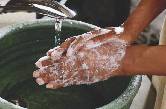- Navigating Your Midlife Crisis: Embracing New Possibilities
- City Raccoons Showing Signs of Domestication
- Mapping the Exposome: Science Broadens Focus to Environmental Disease Triggers
- One Week Less on Social Media Linked to Better Mental Health
- Your Brain Changes in Stages as You Age, Study Finds
- Some Suicide Victims Show No Typical Warning Signs, Study Finds
- ByHeart Formula Faces Lawsuits After Babies Sickened With Botulism
- Switch to Vegan Diet Could Cut Your Greenhouse Gas Emissions in Half
- Regular Bedtime Does Wonders for Blood Pressure
- Dining Alone Could Mean Worse Nutrition for Seniors
Antibacterial Soaps Fail to Beat Plain Soap


When it comes to ridding your hands of bacteria, plain old soap is just as good as many “antibacterial” soaps, new research contends.
Lab tests conducted by a team of Korean researchers revealed that when bacteria are exposed to the standard over-the-counter antibacterial ingredient known as triclosan for hours at a time, the antiseptic formulation is a more potent killer than plain soap.
The problem: People wash their hands for a matter of seconds, not hours. And in real-world tests, the research team found no evidence to suggest that normal hand-washing with antibacterial soap does any more to clean the hands than plain soap.
“[The] antiseptic effect of triclosan depends on its exposure concentration and time,” explained study co-author Min Suk Rhee, a professor in the department of biotechnology and the department of food bioscience and technology at the College of Life Sciences and Biotechnology at Korea University in Seoul.
But most people who wash their hands with antibacterial soap do so for less than 30 seconds, Rhee noted, using formulations containing less than 0.3 percent triclosan — the maximum allowed by law. And that combination, he said, is “not adequate for having an antibacterial effect.”
Rhee and his colleagues outline their findings in the Sept. 16 issue of the Journal of Antimicrobial Chemotherapy.
Triclosan is the antibacterial component of liquid soap. In bar formulations, it’s triclocarban, according to the U.S. Food and Drug Administration. These ingredients have been somewhat controversial. Some contend there is no scientific evidence to back up claims that these products are more effective than regular soap. Others have argued that these ingredients aren’t safe.
But there isn’t any proof that triclosan is unsafe, the FDA said. However, the FDA cautioned that animal studies have raised concerns that the antiseptic may interfere with normal hormonal regulation, or may contribute to antibiotic resistance.
To address both issues, in 2013 the FDA proposed passage of a new rule that would — as of 2016 — require soap manufacturers to provide more solid safety and effectiveness research to back up all antibacterial claims related to triclosan. If the rule is ultimately approved, failure to provide such evidence would result in either the relabeling of triclosan soap packaging to remove all antibacterial claims, or the removal of triclosan.
To see if triclosan made a difference in controlling bacteria in the current study, investigators placed 20 strains of bacteria into laboratory test tubes. They exposed the test tubes to both plain soap and soap containing 0.3 percent triclosan. The tubes were preheated to mimic typical hand-washing temperatures, the study said.
When bacteria were continuously exposed to triclosan for very long periods of time — nine hours or more — the antiseptic demonstrated “significantly” stronger antibacterial properties, the researchers said.
However, lab exposure to just 10, 20 or 30 seconds of triclosan soap translated into no more antibacterial benefit than similar exposures to plain soap, the study revealed.
A follow-up test involving 16 healthy adults confirmed these findings. All participants first had their hands exposed to bacteria. They then washed their hands and lower forearms in warm water for 30 seconds with either plain soap or 0.3 percent triclosan soap, the study said.
The result: While both soaps were largely effective at eliminating bacteria, the difference between the two soaps was “non-significant.”
Still, Rhee stressed that this result is not the final word on all antibacterial soap products.
“Our study [only] means that the triclosan in soap does not always guarantee higher antimicrobial efficacy during hand-washing.”
Brian Sansoni, a spokesman for the American Cleaning Institute in Washington, D.C., said his organization believes that “antibacterial soaps and washes remain a part of effective daily hygiene routines for millions of people who want the extra germ-killing benefit that these products offer. They have a long track record of safety and effectiveness, backed by decades of scientific data and research.”
Dr. Leonardo Trasande, an associate professor with the departments of pediatrics, population health and environmental medicine at NYU Langone Medical Center in New York City, said that “this study clearly reinforces the common sense notion that soap and water work just fine.”
“The FDA has raised concerns about the safety of triclosan, and this study shows it may not provide any benefit anyway,” he said. “So, I would say that in most cases plain soap does the trick. Which is what moms have been saying since the 1930s and ’40s. Turns out they were right.”
More information
There’s more on the antiseptic triclosan at the U.S. Food and Drug Administration.
Source: HealthDay
Copyright © 2025 HealthDay. All rights reserved.










